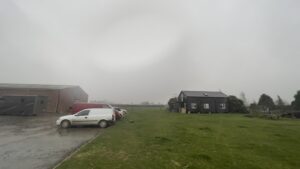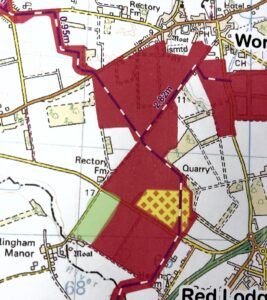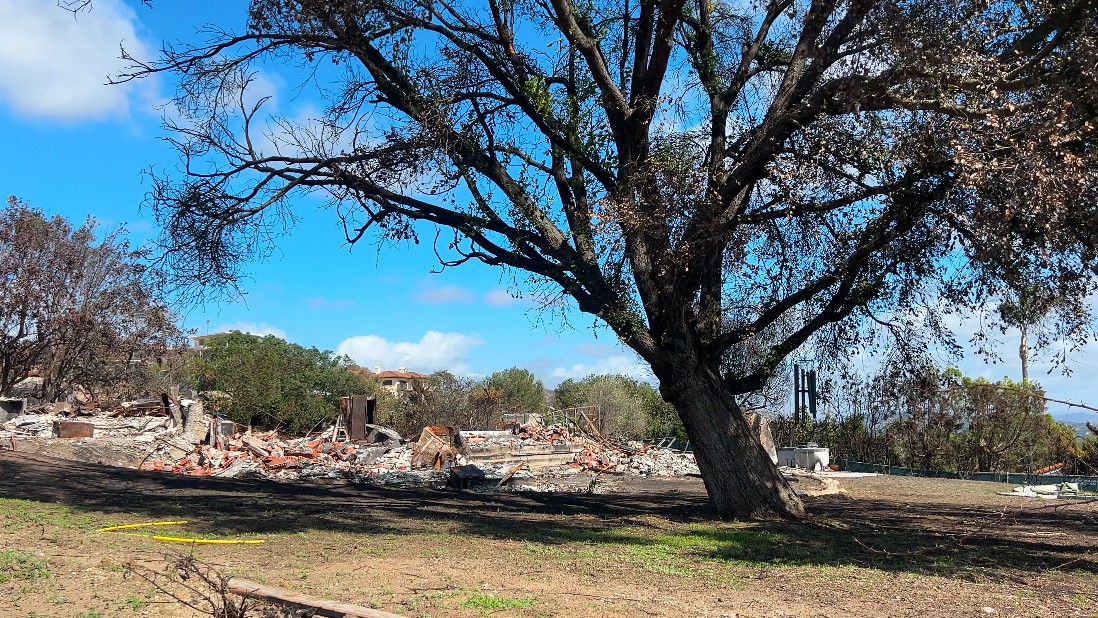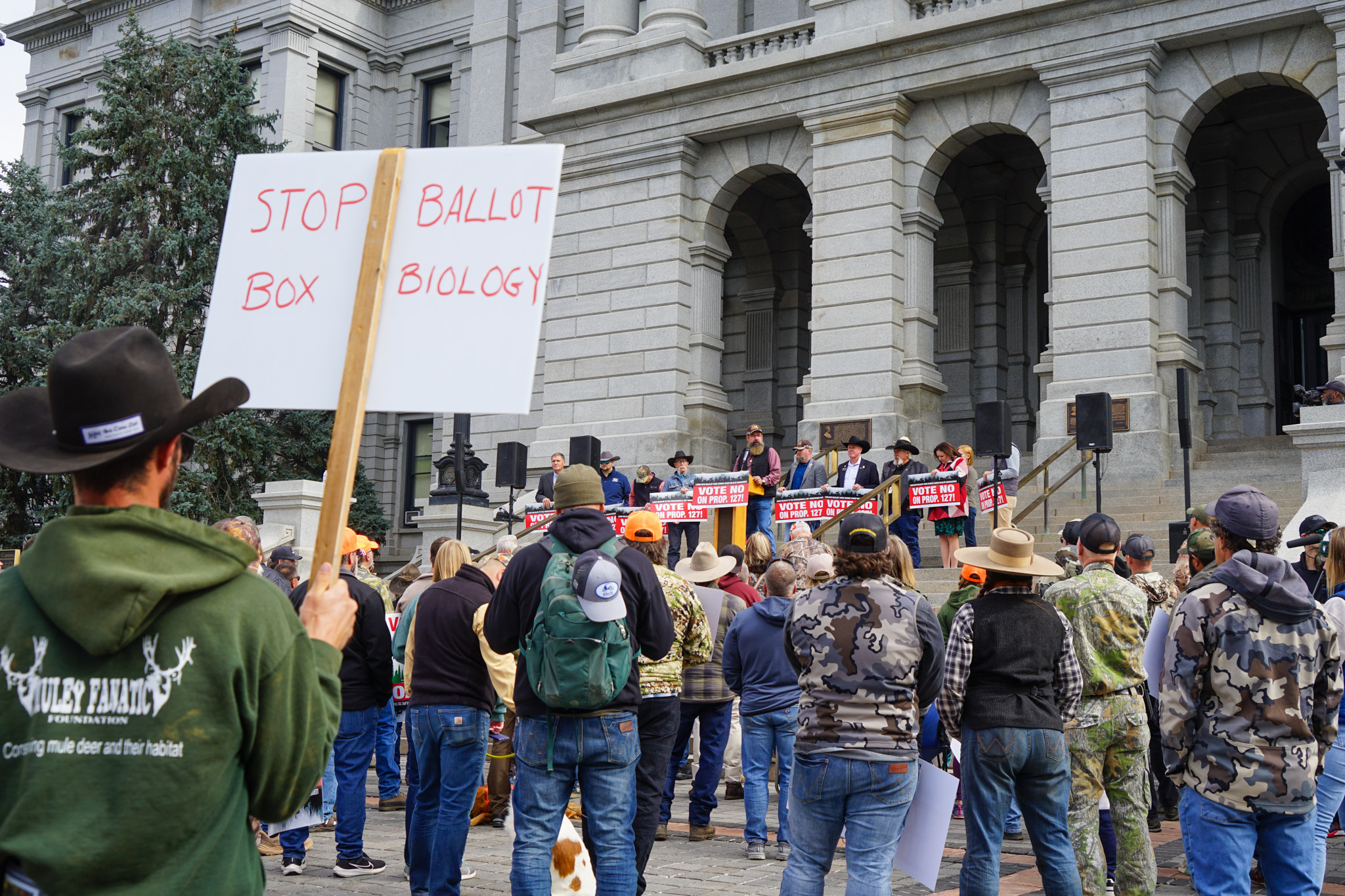(SUFFOLK, England) — Seventy-year-old thoroughbred horse breeder John James likes to survey his horses grazing the land from his balcony. James’ Badlingham property in the East of England is at the heart of the British countryside. He has operated Brookside Stud for the last 15 years at this property, where he houses high-end mares that mate with top-quality stallions in Newmarket, producing some of the best racing horses in the world that are worth millions of pounds. James said when they bought the land, it was bare. The family spent years planting grass seeds and over 6,000 trees and hedges. They also built a paddock for the horses, a barn for all the supplies, and a small family home. James told The Click that now everything precious to him is at stake, including his fantastic balcony view, which is the least of his worries.
James and his family home and business are one of the closest residents to Sunnica East B, one of four separate solar sites that make up Sunnica Energy Farm, the largest P.V. solar facility ever proposed in the U.K. The project will span 2,800 acres of farmland, or over 25,000 NBA basketball courts, and will include a large-scale Battery Energy Storage System (BESS) occupying three out of four solar sites. The largest BESS site is on Sunnica East B, which shares a boundary with James’ property.
Newmarket, a small town just 65 miles north of London, is less than 15 miles away from James’ stud in Badlingham. Newmarket has been considered the ‘headquarters’ of horse racing in Britain since the 17th Century. Today, the town is still home to the largest racehorse breeding center in the country and a prominent British horse racing institution, Tattersalls, responsible for listing and selling some of the world’s best racehorses, breeding stock, and stallions.
James’ stud is in a prime spot to do business with one of the best racehorse institutions in the world. The stud is a family-owned and operated business. “I’m the midwife,” James said with a smile. His wife Kate is the secretary, and their son Daniel runs everything else alongside four full-time staff.
James is on call 24/7 during the foaling. “I don’t have a start to finish,” James said. “I might say at 11 o’clock, ‘Oh, I don’t think [a mare will give birth] tonight, I’ll go get a few hours [of sleep] and then check in again,'” James said.
James cares for female horses, called “mares,” sent from across Europe, including countries like Germany, Sweden, Italy, France, Norway, and Ireland. “[We] breed a few of our own that, you know, go off to the sale to be sold as yearlings or foals. The odd one we’ve put into training ourselves, but we specialize basically in horses, mares that are coming to visit the stallions in Newmarket,” James said.
In early 2018, residents across Suffolk and Cambridgeshire received notice of the plan from a developer called Sunnica Limited, a U.K. joint venture born out of a partnership with two solar developers, Tribus Energy and P.S. Renewables. Many villagers and local M.P.s told The Click they were not pleased to learn of the plan, fearing the project’s consequences on the land and the residents. Farming is a significant industry in Eastern England. James and others said that many people in this area find work through the various crop and animal farms around Suffolk and Cambridgeshire and that their livelihoods are at stake.
“It’s a small business, but it serves a purpose for everybody,” James said of his stud, explaining that he often trades with local feed merchants, hay and straw suppliers, mechanics to fix machinery, builders, and electricians. James said they would all lose valuable work if he were to close down.
Currently, the project is being examined by a government-appointed authority to decide whether they should recommend it for approval to the Secretary of State for Businesses and Industrial Strategy. The examination will take at least six months. Sunnica estimated the project costs to be £600 million, taking at least two years to complete after consent has been granted.
“This proposal is for a massive solar farm … it will completely change the local landscape … it goes right up to village edges. And then there’s a battery farm … the technology we know has caused fires in the past,” said MP Matt Hancock, the former Secretary of State for Health and Social Care who has represented West Suffolk since 2010. Hancock, like most of the community, recognizes the urgency of addressing the climate crisis, and the role of renewables, in doing so. Still, the price his community and others will pay for solar is too high.
“I’m a fan of solar. I’ve supported solar installations in the past … it should be on roofs and in the right place, but this is in the wrong place. It goes right up to people’s homes and will completely change the nature of the local area,” Hancock said.
The scale of the Sunnica project qualifies as an “NSIP,” or Nationally Significant Infrastructure Project. Communities have little say in these decisions other than a brief review period when residents are allowed to share their opinions in writing.
James wrote, “This proposal runs right up to my boundary, where we have high-end mares and foals in the paddocks. I am the closest resident to the storage of the batteries, which occupies a site larger than my stud … The impact this will have on me and my families mental health and the very real prospect of losing our customers who feel it would be too much of a risk to board their Bloodstock so close to this ticking time bomb. It would see the collapse of my business and probably the loss of our home, which would, in effect, be unsalable.”

The family home is the black structure on the right, and the paddock is on the left. [Credit: Autumn Scott]

James’ property is highlighted green. The proposed BESS site is yellow with orange squares. The red is solar panels. [Credit: Sunnica / Photo and green highlight by Autumn Scott.]
According to a June 2021 report called “Safety of Grid-Scale Lithium-ion Battery Energy Storage Systems” from scientists at the Institute of Physics, Oxford, and the University of Kent, utility-scale lithium-powered BESS pose a high risk of danger. Batteries can fail by what scientists call thermal runaway or overheating of a single faulty cell, resulting in leaks of toxic gasses that catch on fire and spread rapidly, engulfing the container and everything around it.
These failure events can result in explosions up to 20 times the energy stored, like Beijing in 2021, when firefighters responded to a 25-megawatt hour lithium battery fire on the roof of a shopping mall. Thirty-five firefighters were dispatched to the scene, with 47 fire trucks from 15 different fire stations. An explosion occurred from one of the battery containers killing two firefighters and injuring a third, per the International Association of Fire and Rescue Services.
Edmund Fordham, a fellow at the Institute of Physics who co-authored the June 2021 report, said serious risks are associated with scaling up lithium-ion batteries.
“What I’m concerned with is the amount of energy that is going to be let loose in a very short space of time if you get one of these battery thermal runaway events because any sort of situation where you’ve got large amounts of energy stored in one place if it gets loose … it’s going to go on a rampage,” Fordham said.
Fordham said that Sunnica’s proposal allows enough land for 3,000-megawatt hours, making Sunnica Energy Farm’s BESS possibly the largest in the world.
“It’s fair to estimate that the Beirut explosion in August of 2020 had a capacity of about 600-megawatt hours worth of energy. Sunnica is proposing five times that amount,” he said.
“I’ve been criticized for that [estimate] because am I saying that it would all go up in one big bang like what happened in Beirut? No, I’m not. I’m much more concerned about the propagation of a series of smaller explosions that progresses from cabin to cabin, particularly if the cabins are closely spaced … What I am saying is that if you lose control of large chunks of 3,000-megawatt hours, you could be doing an equivalent amount of damage to what was done in Beirut,” Fordham said.
James, the stud owner, lives directly 500 meters away from Sunnica East B, where the largest of the three proposed battery sites will be installed. The proposed BESS site totals about 40 acres, or twice the size of Buckingham Palace.
James said he is terrified of a possible BESS failure event that he said would wreak havoc over his property.
Despite the disruption to landowners like James that the renewable energy sites can create, Ram Gupta, professor of chemical and life science engineering at Virginia Commonwealth University, said batteries are integral to a sustainable future. Gupta is one of America’s leading researchers on sustainable energy, materials, and technologies. He said battery research, improvement, and implementation are necessary because they reduce the reliance on fossil fuels.
In 2020, Gupta and his team of researchers at Virginia Commonwealth University received a $2.5 million grant from the U.S. Department of Energy to enhance battery life, reduce costs, and improve battery safety.
“Solar power makes the electricity really green and quite inexpensive now, and that could be combined with batteries so that the two together can solve the [carbon] problem. Otherwise, we’re burning natural gas continuously and throwing CO2 into the air,” Gupta said.
Gupta said the tricky part is that the batteries rely on chemical reactions to produce the energy, and scaling up the technology is challenging.
“There is a limit on how much power [batteries] can hold. There is a safety aspect with the fundamental design […] The more energy you put in when you have a fire, it is just going to be more problematic,” Gupta said.
While lithium-ion technology has allowed for significant electronics and energy storage advancement, experts like Micheal Jones agreed that large-scale lithium-ion batteries are problematic.
“When lithium batteries fail, they tend to fail in a more spectacular manner,” Jones said.
Jones has been a chartered forensic fire and electrical investigator in the United Kingdom for thirty years. He investigates the cause of many types of fires, including those in gas-powered and electric vehicles, buildings like warehouses and factories, electrical systems in solar power and high voltage cables, and lithium-ion batteries.
“Battery failures have been around for a very long time,” he said, but lithium intensifies their complexity. Jones said lithium is a very delicate metal that will even react with water, so if you are trying to attack one of these fires using water, you have got to put a lot on very quickly to try and quench it, which is very difficult.
Thermal runaway events are commonly known as “battery fires” but are not typical fires because they do not require oxygen to burn, instead propagated by the chemicals within the batteries. The fires are uncontrollable except by extravagant water cooling.
The June 2021 report from the scientists at three renowned universities cited battery incidents worldwide, including in April 2021, when a Tesla Model S crashed in Houston, Texas, and sparked a lithium fire because of the car’s battery, which was 0.1 megawatt-hours in size. The fire took four hours to control and 30,000 gallons of water to cool.
Sunnica proposed a BESS capacity of 500 megawatts. The report said that is over 7,000 times bigger than the battery fire sparked in the Tesla.
Sunnica’s “Outline Battery Fire Safety Management Plan” said the battery containers will be compact with several cells or lithium-ion units. Many cells will create a single module. Then the modules will be stacked vertically within a rack. The containers will have multiple racks accessible from one end of the enclosure.
![Many lithium-ion cells will be contained in one module. [Credit: Screenshot from the public document Outline Battery Fire Safety Management Plan from Sunnica Limited.]](https://theclick.news/wp-content/uploads/cache/2022/05/Screen-Shot-2022-05-01-at-6_43_57-PM/714310175.png)
![Modules will be stacked vertically within a rack. The containers will have multiple racks that can be accessed from one end of the enclosure.
[Credit: Screenshot from the public document Outline Battery Fire Safety Management Plan from Sunnica Limited.]](https://theclick.news/wp-content/uploads/cache/2022/05/Screen-Shot-2022-05-01-at-6_50_56-PM/1340392145.png)
![The modules are then stacked vertically to make up one rack. The containers will have multiple racks. [Credit: Screenshot from the public document Outline Battery Fire Safety Management Plan from Sunnica Limited.]](https://theclick.news/wp-content/uploads/cache/2022/08/Screen-Shot-2022-05-01-at-6_51_05-PM/1540712712.png)
![This is what the final BESS containers look like once they are installed. The BESS enclosures will be modified ISO shipping containers or modular pre-manufactured containers according to Sunnica’s outline. Sunnica reports that the maximum dimensions of the containers will be 17 meters by 5meters and 6 meters high from the ground up. [Credit: Screenshot from the public document Outline Battery Fire Safety Management Plan from Sunnica Limited.]](https://theclick.news/wp-content/uploads/cache/2022/05/Screen-Shot-2022-04-14-at-7_52_03-PM/3677160104.png)
The BESS enclosures will be modified ISO shipping containers or modular pre-manufactured containers according to Sunnica’s outline. Sunnica reported that the maximum dimensions of the containers will be 17 meters by 5 meters and 6 meters high from the ground up.
Fordham said all it takes is just one of the cells inside a module to fail, and when you have many cells and modules densely packed together, the likelihood of thermal runaway becomes much higher.
Sunnica said that the Outline Battery Fire Safety Management Plan was developed with the local fire and safety authorities, the Suffolk Fire and Rescue Service.
“We take safety extremely seriously and have published an Outline Battery Fire Safety Management Plan as part of our Development Consent Order application. This sets out our proposed measures to reduce any fire risk through procurement and design and also details our proposed internal fire suppression and external fire fighting systems,” a spokesperson from Sunnica said.
Fordham said no existing engineering standards adequately address thermal runaway or require measures to prevent runaway events. He said the entire responsibility for significant accident planning for large-scale BESS currently lies with local fire and rescue services.
Jones said that shifting the responsibility entirely onto the local fire brigade can be an issue depending on how well trained and equipped they are. Jones said that local fire brigades struggle to control lithium fires because they often think the fire is out but are caught off guard when the fire later reenergizes because of the heat trapped inside the battery.
James, the stud owner, is considering selling the life he has made for himself over the last 15 years to escape the danger, finding somewhere “farther afield,” he told me, “Just to get away from it,” he said.
However, James feels he would be giving up a large part of himself.
“We bought [the land] from the Church of England over fifteen years ago,” James said. “We bought [the land] at the pub in the village at auction.”
He said their family has put in so much physical and mental labor to develop this property over the years. He’s watched the hedges he planted grow taller and the grass he planted fill throughout the land for the horses to graze peacefully.
James said they would be torn to leave and would rather live in Badlingham for the rest of his life.
“But this is, you know, a lovely little hamlet, Badlingham,” James said longingly. “Because there’s only three families in Badlingham … And we’ve all got horses … we all get on well, but we don’t tread on each other’s toes. You know, we help each other out and … it’s a nice little [community], you know?” James said.
James feels as though he is forced to make a potentially life-changing decision thanks to the predicament of this significant infrastructure project. Even just the announcement of the proposal put a damper on prospects of selling the land. James said he has a difficult decision to make because he can try to sell his land now and get what he can for it, losing all the work he has put in, relocating his entire business and family, just for the project not to get approval, or wait for project approval to move. However, if it does get approved, it will be too late to sell at a profit by that time.
Even with the threat of losing everything, he continues on the way he has for the last 15 years.


